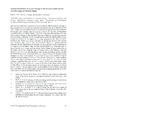
Antarctic Legacy Archive
Spatial distribution of mouse damage to the keystone plant species Azorella selago on Marion Island
- ALSA Home
- →
- Documents
- →
- Research: Events, Presentations, Posters
- →
- View Item
JavaScript is disabled for your browser. Some features of this site may not work without it.
| dc.contributor.author | Phiri, E.E. | |
| dc.contributor.author | Chown, S.L. | |
| dc.contributor.author | McGeoch, M.A. | |
| dc.coverage.spatial | sub-Antarctic | |
| dc.coverage.spatial | Marion Island | |
| dc.date.accessioned | 2021-03-10T09:25:43Z | |
| dc.date.available | 2021-03-10T09:25:43Z | |
| dc.date.created | 2007/10/09 | |
| dc.date.issued | 2007/10/09 | |
| dc.identifier.uri | http://hdl.handle.net/123456789/28565 | |
| dc.description.abstract | Mus musculus domesticus 1 populations on sub-Antarctic Marion Island are thought to have increased in recent years due to climatic amelioration and the eradication of feral cats2 3. It has been shown that mice have the potential to significantly alter ecosystem functioning3. For example, mice have played a role in the reduction of indigenous invertebrate fauna on Marion Island3 4. Recently it has been observed that mice may have a negative impact on the long-lived, keystone, indigenous vascular plant species, Azorella selago (Apiaceae). This is of conservation concern for Marion Island's biota, because (in addition to the impact on A. selago populations) the effect of mouse damage on the vitality of A. selago could alter the distribution of many other species (e.g. epiphytic plant species5 and invertebrates6). Moreover, geomorphological processes, like the stabilisation of substrates, are also dependent on the occurrence of A. selago on Marion Island7. Here, we map the distribution of A. selago and signs of mouse activity on A. selago cushions across Marion Island using a combination of systematic and ad hoc sampling. Signs of mouse activity were observed from sea level up to ca. 765 m a.s.l. (Katedraalkrans hut); whereas the highest altitude recorded for mouse damage to A. selago was 548 m a.s.l. In plots (15 m x 10 m) where mouse damage to A. selago was recorded, 33 % of mouse burrows were recorded to occur in cushions with an average of 18.0 (± 1.5 SE) per plot. Damage to A. selago cushions ranged from single to multiple burrows and, in some cases the excavation of entire cushions, suggesting that mice can kill A. selago. Furthermore, these results imply that mice have a negative effect on A. selago everywhere on the island, and thus, there is little refuge for the keystone species for as long as mice are present on Marion Island. It appears that the impact of mice on the indigenous flora of Marion Island has been overlooked, but the establishment of long-term monitoring plots can aid studies of the effects of mice on this keystone species. | en_ZA |
| dc.description.sponsorship | Sponsored by the the Department of Science and Innovation(DSI) through National Research Foundation (NRF) - South Africa | en_ZA |
| dc.description.statementofresponsibility | Antarctic Legacy of South Africa | en_ZA |
| dc.format | en_ZA | |
| dc.language | English | en_ZA |
| dc.publisher | South African National Antarctic Programme (SANAP) | en_ZA |
| dc.relation | SANAP Symposium 2007 | en_ZA |
| dc.relation.ispartof | ARESSA THEME III: Biodiversity: Responses to Earth System Variability (Posters) | en_ZA |
| dc.rights | Copyright | en_ZA |
| dc.rights | Copyright | en_ZA |
| dc.subject | Research | en_ZA |
| dc.subject | Science | en_ZA |
| dc.subject | Meetings | en_ZA |
| dc.subject | Symposium | en_ZA |
| dc.subject | SANAP Symposium 2007 | en_ZA |
| dc.subject | sub-Antarctic | en_ZA |
| dc.subject | Marion Island | en_ZA |
| dc.subject | Living Systems | en_ZA |
| dc.subject | Research | en_ZA |
| dc.subject | Terrestrial Science | en_ZA |
| dc.subject | Biological Research | en_ZA |
| dc.subject | Plants | en_ZA |
| dc.subject | Flora | en_ZA |
| dc.subject | Invasion Biology | en_ZA |
| dc.subject | Conservation Ecology | en_ZA |
| dc.subject | Zoology | en_ZA |
| dc.subject | Mammals | en_ZA |
| dc.subject | Mouse | en_ZA |
| dc.subject | Invasive Species | en_ZA |
| dc.subject | Vascular Plants | en_ZA |
| dc.title | Spatial distribution of mouse damage to the keystone plant species Azorella selago on Marion Island | en_ZA |
| dc.type | Abstracts | en_ZA |
| dc.rights.holder | Antarctic Legacy of South Africa | en_ZA |
| dc.rights.holder | Phiri, E.E. | en_ZA |
| dc.rights.holder | Chown, S.L. | en_ZA |
| dc.rights.holder | McGeoch, M.A. | en_ZA |
| iso19115.mdconstraints.uselimitation | This item and the content of this website are subject to copyright protection. Reproduction of the content, or any part of it, other than for research, academic or non-commercial use is prohibited without prior consent from the copyright holder. | en_ZA |
| iso19115.mddistributor.distributorcontact | South African National Antarctic Programme (SANAP) | en_ZA |
| iso19115.mdformat.name | en_ZA | |
| iso19115.mdidentification.deliverypoint | Antarctic Legacy of South Africa, Faculty of Science, Private Bag X1, Matieland. Stellenbosch. South Africa. | en_ZA |
| iso19115.mdidentification.electronicmailaddress | antarcticlegacy@sun.ac.za | en_ZA |
| iso19115.mdidentification.organizationname | Stellenbosch University | en_ZA |
Files in this item
This item appears in the following Collection(s)
-
Research: Events, Presentations, Posters [480]
Material directly related to official scientific and research events
